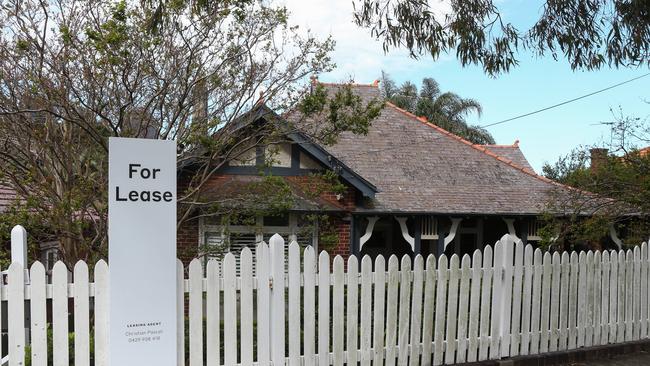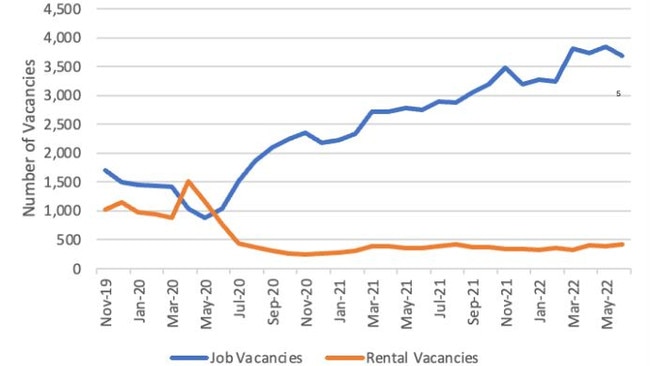How Australia’s housing crisis is burning a $2.6 billion hole in the economy
Australia’s housing crisis has blown a multi-billion dollar hole in the economy – and if something doesn’t change then things are going to get a lot worse.
National
Don't miss out on the headlines from National. Followed categories will be added to My News.
Australia’s housing crisis is impacting a lot more than people’s ability to find a home, with the problem blowing a huge hole in our economy.
Millions of Australians are feeling the impact of the worsening crisis, with skyrocketing rental prices and a lack of availability meaning many residents are now facing homelessness for the first time in their lives.
Now, the flow on effects of the situation are really starting to be felt – particularly in regional areas – with employers struggling to attract staff due to the lack of affordable housing for potential employees.
A special Impact Economics analysis of five regional economies commissioned by Everybody’s Home has shined a light on the connection between increased rents, low vacancy rates and unfilled job vacancies.
The study looked at housing in the Queensland Sunshine Coast, NSW South Coast, Launceston-North East Tasmania, SA Fleurieu Peninsula and Geelong/Surf Coast in Victoria.

The results found the shortage of affordable housing in these areas alone is burning a $2.6 billion hole in the local economies by directly undermining the capacity of employers to attract staff.
Kate Colvin, national spokesperson for the Everybody’s Home campaign, said the chronic lack of affordable housing in regional communities is “more than a social crisis”, branding it a “deep economic crisis” as well.
“The inability to find a rental and eye watering rent increases for the few places available is deterring people from taking up jobs in regional communities,” she said.
“Employers tell us constantly that prospective employees tell them they can’t move to the community if they can’t find a place to live.
“Our completely lopsided housing system is choking off the economic potential of regional Australia.”
Let’s take a look at the shocking economic impact this crisis is having on our regional communities.
The Sunshine Coast has seen a 36 per cent rise in average rent prices since March 2020.
The study found 39 per cent of low income households are experiencing severe rental distress, which is a 15 point increase since March 2020.
In that time, the number of job vacancies have jumped from 1415 to 3678, resulting in a lost economic output of $786 million per year.

Taking a look at Victoria’s Geelong/Surf Coast area, there has been a 17 per cent rise in rental prices since March 2020, with the number of households experiencing rental stress increasing by five points to 26 per cent in that same period.
The number of job vacancies has jumped by a massive 133 per cent from 1454 to 3401.
This means the lost economic output due to vacant jobs is sitting at $760 million per year.
Over in NSW, the Illawarra/South Coast region has seen a huge 41.7 per cent increase in rental prices, with the number of low income households are experiencing severe rental distress increasing 20 points to 46 per cent.
As a result, the region is experiencing a lost economic output of $642 million following the number of job vacancies increasing to 1333 from 2848 since March 2020.

The number of available houses for each job as significantly dropped across regional areas, and is often well below the major capital cities.
For example, in Geelong and the Surf Coast there is only one house for every ten jobs, compared to one house for every six jobs in Melbourne.
In the Illawarra and South Coast, there is one house for every eight jobs, compared to one house for every five jobs in Sydney.
Those living in South Australia’s Fleurieu Peninsula have seen a 48 per cent spike in rent prices, along with a 20 point increase to 38 per cent of low income households dealing with major rental stress.
There has been 119 per cent increase in job vacancies since March 2020 – jumping from 426 to 932 – resulting in a $201 million economic loss each year.
Down in Launceston/North East Tasmania, there has been a 21 per cent increase in rental prices and a seven point increase in rental stress, meaning 36 per cent of low income households are now experiencing severe rental stress.
Since March 2020, the number of job vacancies has increased from 382 to 876, resulting in a lost economic output due to vacant jobs of $201 million per year.
The new data has been released ahead of the upcoming jobs and skills summit, which will see employers meet with the government and unions to discuss solutions to stagnating wages, jobs security and skills shortages.
Ms Colvin said the connection between housing and jobs needs to be “at the very top” of the agenda for the summit.
“Expanding social and affordable housing by building an additional 25,000 new dwellings per year would give people on modest incomes more choice,” she said.
Ms Colvin said a move like this would relieve serious pressure on Australia’s housing system, allowing regional communities the chance to “flourish economically”.
“We need a better balanced housing system that supports social inclusion and fosters economic growth,” she said.
“The housing needs of Australian workers warrant serious attention at the employment summit.”
Anthony Albanese’s job summit follows in the footsteps of the Hawke government’s 1983 economic summit and Kevin Rudd’s Australia 2020 summit held in 2008.
Mr Rudd’s summit brought together 1000 of the “best and brightest” to map out solutions to challenges in employment, environment, the arts and health.
But suggestions the summit could be reduced to a talkfest, as some have claimed the Rudd summit was, were quickly rebuked by the Prime Minister.
“The Rudd 2020 summit was the first time anyone heard of the National Disability Insurance Scheme; pretty significant reform that came out of that process,” Mr Albanese hit back.
“Already, I regard (the summit) as a success.
“The fact that you are all here and we are talking about jobs and skills is part of the process of what we are doing here – making sure that people understand that there are significant skills shortages.”
Originally published as How Australia’s housing crisis is burning a $2.6 billion hole in the economy





